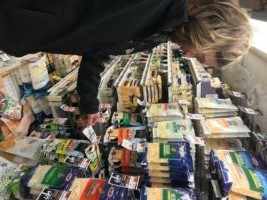Economic Development in the Local Food Economy
October 10, 2017

When you ask people their definition of the Vermont food economy, they’ll often talk about farms, farmers’ markets or CSAs. What’s often missing from the conversation are the supply chain of local businesses such as distributors, food processors and manufacturers, and seed, feed, and equipment dealers.
Vermont’s local food economy not only extends well beyond the farm, it’s also an important part of our state’s economic engine. Sales from food and beverage manufacturing and wholesale distribution in 2012 totaled $9.1 billion. In terms of employment across the food system—spanning farm inputs (seed, feed, fertilizer), production, processing, distribution, and retail—64,000 Vermonters are employed in the food economy.
In Vermont, local food is considered to be anything produced or processed in Vermont plus 30 miles.
Essential to Vermont’s food economy, food manufacturing and processing involve a series of mechanical (chopping, mincing, mixing ingredients) or chemical (fermentation, pickling, curing) operations to preserve or change raw food into other forms, such as cheese, beer, maple syrup, meats, and sauces.
Food and beverage manufacturing has boomed since 2010 as one of the few growing manufacturing sectors in Vermont. Employment increased 47 percent from 2009 to 2015, up from 4,628 jobs to 6,810. Processing and food manufacturing facilities in Vermont represent a diversity of products and scales, from large commercial facilities like Cabot Creamery Cooperative and King Arthur Flour to smaller operations like Green Pasture Meats, Baird Farm Maple Syrup, 14th Star Brewing, and Mad River Food Hub.
The growth in food manufacturing is even more impressive when you contrast growth in food manufacturing with non-food manufacturing in Vermont. From 2004 to 2013, total value-added, non-food manufacturing in Vermont decreased 37 percent (-$2.3 billion). But in the food economy, it’s an entirely different story. Net value-added food manufacturing (when raw products are processed into something else, like beer, salsa, or ice cream) increased 58 percent ($359 million).
A Values-Based Supply Chain
Traditional supply chain businesses view relationships as transactional, competitive, and benefits are unevenly distributed—the average U.S. farmer, for example, only receives approximately 17 cents of each dollar spent on food, while the remainder goes to food service, processing, and retail.
Vermont’s food economy emphasizes the relationships between supply chain businesses and their shared commitments to be financially profitable, as well as provides positive benefits to the community and environment.
In Vermont’s values-based supply chain, businesses work together to boost the entire local economy and contribute to our self-sufficiency as a state.
For Example:
- Butternut Mountain Farm, one of the largest maple processors and distributors in Vermont, has created lasting connections over the past 40 years by purchasing and distributing maple syrup from approximately 350 small producers who manage over 100,000 acres of land, helping get their products into consumers’ homes.
- The Mad River Food Hub in Waitsfield is an incubator for business development, providing processing space and distribution to clients, as well as marketing opportunities through the new Mad River Taste Place.
- Pete’s Greens established The Vermont Farm Fund, which was inspired by the outpouring of support the farm received after a fire destroyed the barn that was the heart of its operation. The fund was started to help other farms get back on their feet and has evolved to include a Business Builder Loan Program that’s designed to help other food businesses innovate and grow. Since 2011, the Fund has lent $764,000.
These are just a few examples of numerous Vermont food system businesses who are going beyond the traditional supply chain model to succeed in the local, regional, and national marketplace.
Local food is truly a bright spot in Vermont’s local economy. Increasing consumer purchases of local food keeps more money here in Vermont—and in turn creates jobs, supports businesses committed to their communities, protects family farms, and helps more local food be accessible for more Vermonters.
Learn more about the work taking place to implement Vermont’s Farm to Plate food system plan at www.vtfarmtoplate.com.
Get involved in the Farm to Plate Network’s Rooted in Vermont movement to increase consumer demand for local food. #RootedinVermont – Facebook Twitter Instagram




